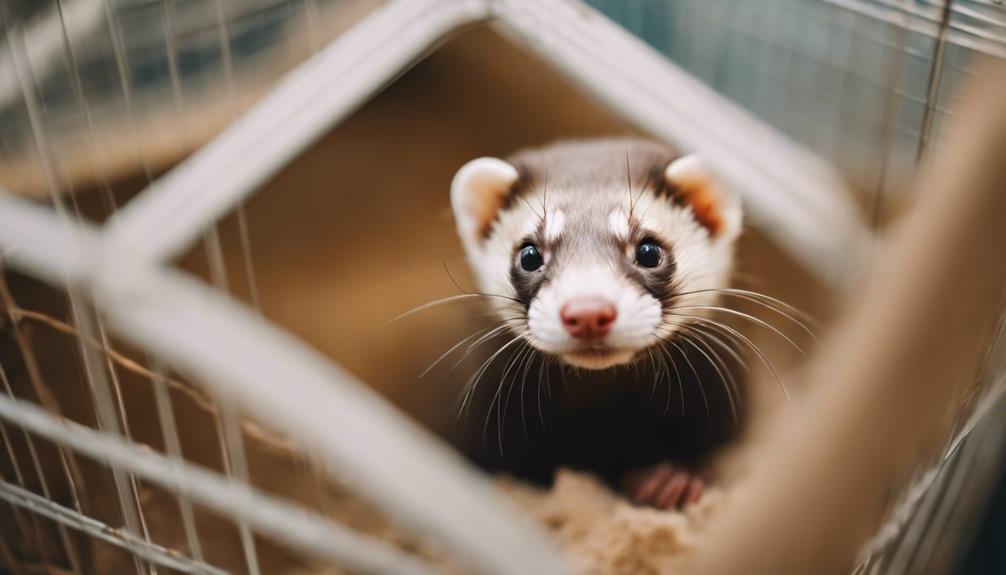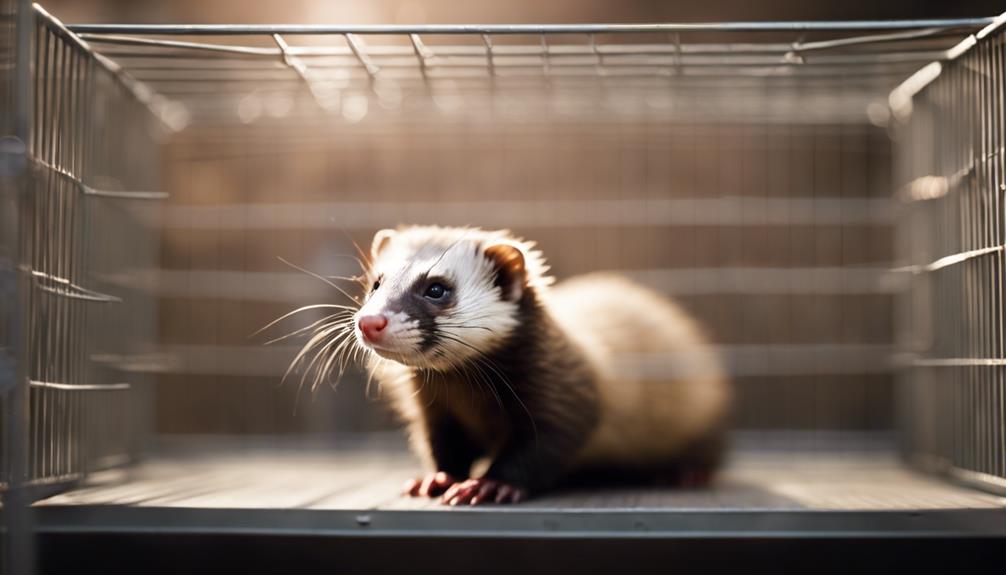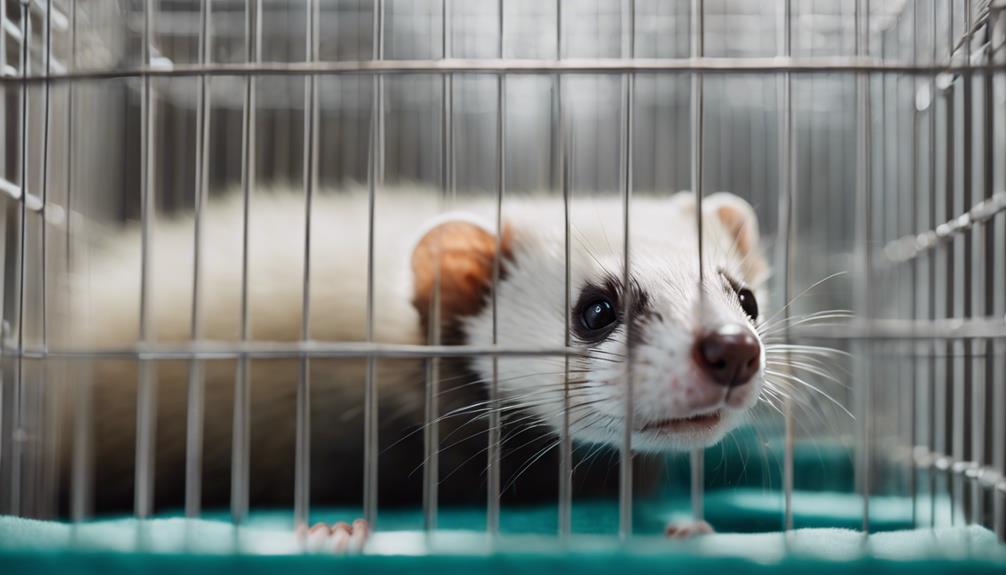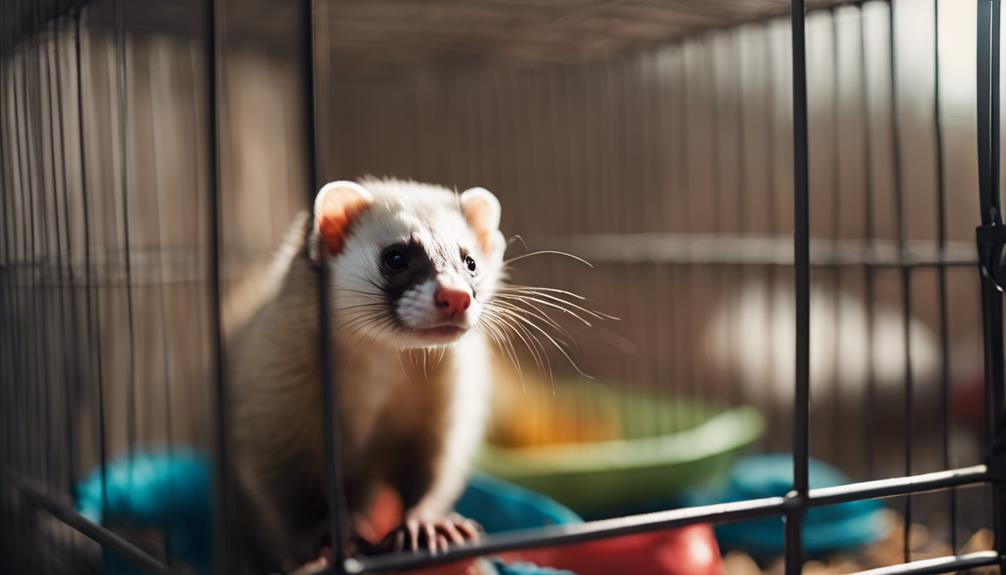How to Choose the Perfect Cage Size for Your Ferret

Choosing the Perfect Cage Size for Your Ferret:
Factors like activity level and mental stimulation are key.
Make sure the cage is spacious enough for their well-being and happiness.
Importance of Cage Size
When considering the well-being of a ferret, the importance of cage size can't be overstated. A properly sized cage is crucial for providing adequate living space and promoting a healthy environment for these playful creatures. Ferrets are known for their high energy levels and curious nature, making it essential to offer them ample room to move around and explore. A spacious cage allows for the inclusion of various cage enrichment items such as tunnels, hammocks, and toys, which help stimulate their minds and prevent boredom.
Moreover, a well-sized cage also impacts the frequency and duration of ferret playtime outside of the cage. When a ferret has enough space to exercise and play within its enclosure, it's likely to be more content and less restless, leading to more enjoyable play sessions when outside the cage. This, in turn, contributes to the overall well-being and happiness of the ferret. Therefore, investing in a suitable cage size is a fundamental aspect of caring for these lively pets.
Understanding Ferret Behavior

Ferrets are known for their burrowing instincts, often seeking out cozy spaces to rest and play.
Additionally, ferrets have a natural inclination to climb, exploring vertical surfaces and seeking elevated spots.
Understanding these behaviors is crucial when considering the space requirements for a ferret cage to ensure their well-being and enrichment.
Ferret Burrowing Instincts
With their natural burrowing instincts, ferrets are inclined to create cozy dens underground or in enclosed spaces. To satisfy this behavior in captivity, providing burrowing enrichment is essential.
Ferrets exhibit digging behavior by using their sharp claws to excavate and create tunnels or nesting areas. Owners can incorporate items like tunnels, boxes filled with safe bedding material, or even dedicated burrowing boxes in the cage to simulate this natural behavior.
Ferret Climbing Tendencies
To further comprehend ferret behavior, it's crucial to acknowledge their inclination towards climbing, which plays a significant role in their natural instincts and engagement within their environment. Ferrets exhibit a strong desire for vertical space and climbing opportunities, which can be fulfilled through various means:
- Climbing enrichment: Providing structures like ramps, ladders, and shelves can satisfy their climbing instincts.
- Vertical space utilization: Ferrets enjoy exploring and playing in elevated areas, so offering multiple levels in their cage is beneficial.
- Climbing toys: Toys designed for climbing, such as hanging ropes or hammocks, can keep ferrets entertained and active.
- Elevated platforms: Platforms at different heights create a dynamic environment for ferrets to climb, jump, and observe their surroundings.
- Natural branches: Including branches for climbing gives ferrets a taste of their wild instincts and provides exercise and mental stimulation.
Ferret Space Requirements
Understanding the behavior of ferrets is key to determining the appropriate space requirements to meet their needs effectively. Ferrets are active and curious animals that require ample room for exploration and play. To enhance their environment, consider ferret enrichment ideas such as tunnels, hammocks, and interactive toys.
When setting up the cage, utilize space-saving solutions like vertical levels or hanging hammocks to maximize floor space. Cage layout options should include separate areas for sleeping, eating, and playing to cater to their natural instincts. Additionally, incorporate ferret playtime suggestions by providing supervised time outside the cage for exercise and mental stimulation.
Factors to Consider

Considering the activity levels and size of your ferret is crucial when choosing the appropriate cage size. Understanding these factors will help create a comfortable and stimulating environment for your pet. Here are some essential factors to consider:
- Cage Enrichment: Providing toys, hammocks, and hiding spots can keep your ferret mentally engaged.
- Playtime Schedule: Ferrets are highly active animals and require daily playtime outside of their cages.
- Multi-level Habitats: Ferrets enjoy climbing and exploring different levels within their cages.
- Ferret Tunnels: Adding tunnels can offer additional opportunities for play and exercise.
- Space for Litter Box: Ensure the cage has ample space for a litter box to maintain cleanliness and hygiene.
Measuring for the Right Fit

When ensuring the right fit for your ferret cage size, start by measuring the available space in your home that can accommodate the cage dimensions. Consider the cage height to ensure your furry friend has enough vertical space to move around comfortably.
Ferrets are active animals that love to climb and explore, so a taller cage can provide more opportunities for them to satisfy their natural behaviors. Additionally, think about tunnel options when measuring for the right fit. Ferrets enjoy playing and hiding in tunnels, so having enough room to include tunnels within the cage can enhance their living environment.
Minimum Cage Size Recommendations

When considering the minimum cage size for a ferret, it's crucial to adhere to size requirements for these active pets. Providing ample space allows for the ferret to exercise and explore, promoting their physical and mental well-being.
Tailoring the cage dimensions to accommodate the ferret's high activity level ensures a comfortable and enriching environment for your pet.
Size Requirements for Ferrets
To ensure the well-being of ferrets in captivity, it's crucial to provide a cage that meets the minimum size recommendations for their comfort and health. When considering the size requirements for ferrets, here are some key points to keep in mind:
- Cage dimensions: The cage should be at least 24 inches wide, 24 inches deep, and 18 inches high.
- Ferret enclosure: Opt for a multi-level cage to provide ample space for your ferret to move around and engage in natural behaviors.
- Ventilation: Ensure the cage has proper ventilation to maintain good air quality.
- Accessibility: Include multiple doors or large openings for easy cleaning and interaction with your ferret.
- Flooring: Choose a cage with a solid bottom to prevent your ferret's feet from getting trapped.
Space for Ferret Exercise
The space provided for ferret exercise within their cage should meet or exceed the minimum size recommendations to ensure their physical and mental well-being. To promote active playtime options and ferret enrichment, consider a cage with enough room for your furry friend to move around freely.
Include elements like ferret tunnels for indoor exploration and to satisfy their natural curiosity. Ferrets are energetic animals that require space for outdoor exploration, so a larger cage allows for more opportunities for them to stay active and engaged.
Providing a stimulating environment within the cage can prevent boredom and promote a healthy lifestyle for your ferret. Remember, ample room for exercise is key to keeping your ferret happy and healthy.
Consider Ferret's Activity Level
Considering the ferret's activity level is crucial when determining the minimum cage size recommendations to ensure their well-being and happiness. Ferrets are highly active animals that require ample space to move around, play, and explore. When evaluating the cage size based on their activity level, it's essential to take into account the following:
- Ferret playtime needs: Ferrets need daily play sessions outside of their cage to stay physically and mentally healthy.
- Cage enrichment options: Providing tunnels, hammocks, and toys inside the cage can help keep ferrets entertained and engaged.
- Vertical space: Ferrets enjoy climbing, so cages with multiple levels or shelves are beneficial.
- Room for exercise: A spacious cage allows ferrets to run, jump, and stretch, promoting their overall well-being.
- Hideouts and cozy spots: Including hiding places in the cage gives ferrets a sense of security and comfort.
Cage Setup and Accessories

When setting up your ferret cage, ensure to provide a variety of accessories that cater to their natural behaviors and needs. Cage enrichment is crucial for keeping your ferret mentally stimulated and physically active. Include items like tunnels, hammocks, climbing platforms, and toys to encourage exploration and play.
Proper ventilation is essential to maintain a healthy environment inside the cage. Make sure there's adequate airflow to prevent the buildup of odors and ensure your ferret has access to fresh air at all times. Additionally, consider adding a litter box to help with potty training and keep the cage clean.
Water bottles or bowls should be easily accessible and securely attached to the cage to provide constant access to clean water. Providing cozy bedding materials like fleece blankets or towels can offer your ferret a comfortable place to rest.
Monitoring Your Ferret's Comfort

To ensure your ferret's well-being, regularly check for signs of discomfort or distress in their behavior and physical condition. Observing your ferret closely will help you understand their comfort levels and make necessary adjustments to their environment. Here are some key points to consider when monitoring your ferret's comfort:
- Behavior Patterns: Watch out for changes in your ferret's behavior, such as increased aggression, excessive hiding, or unusual vocalizations, as these could be signs of discomfort.
- Physical Condition: Regularly inspect your ferret for any physical signs of distress, such as hair loss, skin irritation, or unusual lumps.
- Environmental Adjustments: Ensure that the temperature, lighting, and humidity levels in your ferret's cage are suitable for their well-being.
- Interaction: Monitor how your ferret interacts with their cage mates or toys, as this can indicate their comfort levels.
- Diet and Hydration: Keep track of your ferret's eating and drinking habits, as changes in appetite or water intake could signal discomfort or illness.
Frequently Asked Questions
Can Ferrets Be Kept in Pairs or Groups in the Same Cage, or Do They Need Individual Cages?
Ferrets can thrive in pairs or groups in the same cage, benefiting from social interaction. Cage compatibility is essential to prevent conflicts. Providing a spacious environment and multiple hideouts can promote their well-being and mental stimulation.
Are There Any Specific Requirements for Cage Placement Within a Home That Should Be Considered?
When considering cage placement for a ferret, it's crucial to ensure adequate ventilation to maintain air quality. Positioning the cage where natural light can reach it helps regulate their circadian rhythm. These factors contribute to a healthy environment for your pet.
How Often Should the Cage Be Cleaned and What Cleaning Products Are Safe to Use?
While some may dream of a self-cleaning cage, ferret owners must roll up their sleeves. The cage should be cleaned at least once a week. Use pet-friendly products like diluted vinegar or mild soap for a squeaky-clean abode.
Can Ferrets Be Let Out of Their Cage to Roam Freely, and if So, How Much Time Should They Be Allowed Outside of Their Cage?
Ferrets can be let out of their cage for indoor exploration and playtime. It's essential to provide supervised freedom for exercise opportunities. Experts recommend allowing ferrets a few hours daily outside their cage in a safe, ferret-proofed area.
Are There Any Specific Types of Toys or Enrichment Activities That Are Recommended for Ferrets to Keep Them Mentally Stimulated While in Their Cage?
When selecting toys and enrichment activities for ferrets, consider options like tunnels, hammocks, and puzzle feeders to keep them mentally stimulated. These items can help alleviate boredom in their cage, complementing appropriate cage size considerations.











